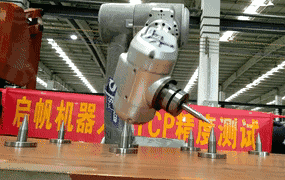What is industrial robot TCP?
In order to describe the pose of a rigid body in space, it is necessary to fix a coordinate system on the object, and then determine the pose of the coordinate system (origin position and three coordinate axes), that is, 6 DOFs are needed to completely describe the position of the rigid body. Pose [1]. For industrial robots , you need to install the tool at the end of the wheel. To determine the pose of the tool, a tool coordinate system TCS (Tool Coordinate System) is bound to the Tool. The origin of the TCS is TCP (Tool Center Point). When programming the robot trajectory, it is necessary to record the pose of the TCS in other coordinate systems into the program. The TCP types are: regular TCP, fixed TCP, dynamic TCP.

01
Conventional TCP: moving with the robot body
Industrial robots generally define a TCS in advance. The XY plane of the TCS is bound to the flange plane of the sixth axis of the robot, and the origin coincides with the center of the flange. Although the default TCP can be used directly, in actual use, such as soldering, the user usually defines the TCP point to the tip of the wire (actually the coordinate of the torch tool in the tool0 coordinate system), then the program records The position is the position of the tip of the wire, and the recorded posture is the attitude of the torch rotating around the tip of the wire.
02
Fixed TCP
Define TCP as a location that is stationary outside the robot body. Often used on the glue, the glue tank nozzle is stationary, and the robot grabs the workpiece to move. Its essence is a workpiece coordinate.
02
Dynamic TCP
With more complex applications, TCP can be extended to the outside of the robot body axis (external axis) for applications where TCP needs to be dynamically changed relative to the flange.
With the development of industry, industrial automation technology has gradually matured. More and more high-precision, high-complexity manufacturing industries have placed higher demands on production precision, which has greatly promoted the use of robots in industrial production.
TCP accuracy test reason
With the continuous upgrading of industrial automation production in the world, industrial robots, which are one of the main means of production automation, have been widely used in industrial production. They have not only been widely used in handling, painting, welding, etc., but also started. Used in ultra-precision operations such as automatic assembly and dimensional inspection. At present, robots produced by robot manufacturers have higher repeatability and higher absolute positioning accuracy, which is only millimeters, and cannot meet the requirements of high-precision machining.
TCP accuracy test analysis basis
In the process of robot machining and assembly, inevitably, errors will occur. The wear during the operation of the robot will also cause gaps between the motion pairs, and the actual components will have elasticity. Under high-speed motion, inertia force, gravity and external force will inevitably Problems such as elastic deformation and vibration. The industrial robot is controlled by the kinematic model (shown in Figure 1). The structural parameters caused in the kinematic model are the design values. There is inevitably an error between the actual structural parameters and the robot. It is often difficult to measure these structural parameters directly when the expected pose requires motion.
However, these structural parameter errors must be reflected in a certain form, the most direct manifestation is the TCP accuracy of the end effector. Testing the TCP accuracy of the robot end effector can derive the error source of the robot, and then analyze the off-line software simulation (shown in Figure 2) through the sail accuracy analysis. The effect of the error on the robot end effector can be clearly found. Reasonable distribution and control of various impact factors can achieve the purpose of improving the running accuracy of the robot end effector.

Figure 1 Kinematics model

Figure 2 simulation analysis
32inch Horizontal Query Machine Integrated
3,Information inquires;
4,Guidance system;
5,Products display showcase;
6,Metal frames not easy to damage;
7,Indoor outdoor both avaiable;
8,Multiple sizes satisfy different needs;
9,Capacitive touch lcd screen,smart operation;
10,4+64G,X86 i3 intelcore CPU;
Lcd Touch Screen Query Machine,Capacitive Touch Screen Inquires Machine,All-In-One Query Machine Touch Screen,Advertising Touch Screen Display Kiosk
Jumei Video(Shenzhen)Co.,Ltd , https://www.jmsxdisplay.com